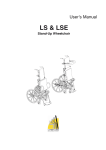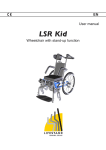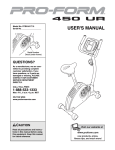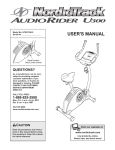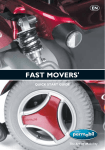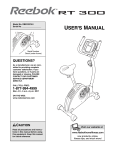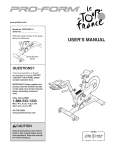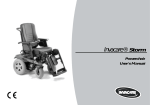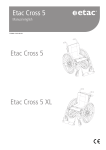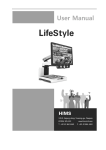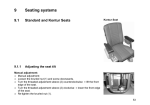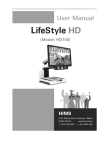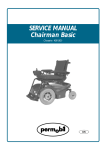Download the H E L I U M
Transcript
Stand-Up Wheelchair User’s Manual the H E L I U M TABLE OF CONTENTS PART 1 : OPERATION DIAGRAMS ............................................................................. 2 INTRODUCTION ........................................................................................................... 7 PART 2 : OPERATING INSTRUCTIONS...................................................................... 9 2.1 Positioning - Seated ................................................................................................9 2.1.1 Footplate/lower leg length adjustment (Fig. 1). ....................................................9 2.1.2 Chest strap height adjustment (Fig. 2).................................................................9 2.1.3 Seat frame depth adjustment (Fig. 3). .................................................................9 2.1.4 Anti-tip tubes (Fig. 4). ........................................................................................10 2.1.5 Back angle adjustment (Fig. 5). .........................................................................11 2.1.6 Backrest angle “compensation” system (Fig. 5).................................................11 2.1.7 Backrest height adjustment (Fig. 6). ..................................................................11 2.1.8 Wheel locks (Fig. 7). ..........................................................................................11 2.2 Standing Up ...........................................................................................................12 2.2.1 Preparing to stand. ............................................................................................12 2.2.2 The Standing Process (Fig. 8). ..........................................................................12 PART 3: SAFETY INSTRUCTIONS ............................................................................ 16 3.1 Use of Wheelchair..................................................................................................16 3.2 Transporting ..........................................................................................................16 3.3 Cleaning .................................................................................................................17 3.4 Maintenance...........................................................................................................17 PART 4: TECHNICAL DATA ...................................................................................... 18 4.1 Specifications ........................................................................................................18 Helium User’s Manual March 2010 1 Part 1 : Operation Diagrams Downpost Figure - 1 Footrest Length/Angle Adjusting Screws Figure - 2 Chest Strap Backrest Tension Strap Figure - 2 b. Chest strap tension adjustment Left strap Single buckle Right strap Double buckle Backrest tubes Helium User’s Manual March 2010 2 Figure - 3 Seat Rail - Upper Seat Rail - Lower Anti-tips Wheels up Figure - 4 Detent Button Rear Wheel Fore-Aft Adjustment Anti-tips Wheels down Frame Pivot Mount Figure - 5 -3° Figure - 6 +12° 2 Back Angle Adjusting Screws 1 3 Helium User’s Manual March 2010 3 Fig. 6 1 inch Armpit Backrest tube and adjusting screws (adjusts in 0.8 inch increments) Fig. 7 Wheel Lock Adjusting Screw Figure 8 Helium User’s Manual March 2010 4 Knee Block Pivot Mount Fig. 9 Retracted position Locking Flange Extended position Pivot Mount Peg Knee Block Pivot Mount Fig. 10 Seat Rail – Upper Figure 11 Safety Lock Seat Rail - Lower Helium User’s Manual March 2010 5 Figure 12: Mechanical Movement to the Standing Position Arm Loop Levers Rotation of Arm Loop Levers to Stand Rotation of Arm Loop Levers to return to Seated Position Grip areas for lifting Figure 13 B A Backrest Stop Lock Helium User’s Manual March 2010 6 INTRODUCTION Congratulations on the purchase of your new LifeStand Stand-up Wheelchair by Permobil! You may have confidence in knowing that you have acquired the best in technology from the worldwide leader in mobility products. Before operating your stand-up wheelchair, it is essential to read and carefully follow the below instructions and operating procedures. Safety and maintenance: 1) Standing environment The stand-up feature of this device must only be used on flat, obstacle free surfaces and away from stairs, ramps, slopes, uneven surfaces or inclines of any kind. 2) Adjustments Adjustments made to a LifeStand stand-up wheelchair, as described in this document or otherwise, must be made by an authorized Permobil dealer. Under no circumstance should these adjustments be made by the end user or non-authorized personnel. 3) Maintenance It is recommended that you complete a weekly and monthly inspection of your wheelchair. recommended that it be serviced annually by an authorized Permobil dealer. It is also 4) Benefits of a Daily Standing Regimen The use of any stand-up device should be done only under the prescription and supervision of a medical professional. At the outset, it is recommended that your introduction to regular standing be closely monitored by your Physical or Occupational Therapist. It has been documented that the regular and cyclical activity of going from the seated to the standing position may offer many benefits to those that are no longer able to stand on their own. The benefits are two fold: 1) there is the ability to once again function in daily activities that necessitate standing (reaching file cabinets and equipment in the workplace, accessing cupboards/stoves/shelving at home, as well as the ability to interact eye to eye); and, 2) the potential of physical benefits that result from repeated standing (these benefits may include improved; range of motion, bone density, circulation, bowel and bladder function, etc.). Label: Compliance of this device to annex I of the EU directive 93/42/EEC is confirmed by this CE label. Helium User’s Manual March 2010 7 Helium User’s Manual March 2010 8 Part 2 : Operating Instructions 2.1 Positioning - Seated 2.1.1 Footplate/lower leg length adjustment (Fig. 1). For sitting comfort, and to be properly positioned to obtain a standing posture, the seat to footplate dimension must be set to the appropriate length. When doing so, it is important that the seat cushion that client will be using on a regular basis is used. When setting the lower leg length, the upper leg position should be parallel to the seat rail, but slightly elevated from the cushion at the front edge. The result is appropriate pressure distribution for the thighs and buttocks when seated and appropriate hip rotation and extension when standing. This adjustment is done by removing the Footrest Length/Angle Adjusting Screws located on the lower part of the downpost. The vertical adjustment is made in .8 of an inch increments. These same screws are utilized to adjust the footplate angle (to plus or minus 5 degrees). 2.1.2 Chest strap height adjustment (Fig. 2). To obtain optimum support for the user, especially when standing, the height of the chest strap can be adjusted. The higher the chest strap is moved up the backrest the greater support it will offer. It is adjusted by simply releasing its Velcro attachments to the back upholstery and relocating. Make certain to weave the backrest straps (which are part of the tension adjustable back system) through the metal retaining rings found on the chest strap. Please note that additional support straps are available if more support is desired. Please contact customer service with questions. 2.1.3 Seat depth adjustment (Fig. 3). 2.1.3.1 Measuring. In seated position, measure the Seat Depth (measured from the front of the backpost to the back of the knee). 2.1.3.2 Seat depth adjustment (Fig. 3). Adjust the Upper Seat Rail first, leaving the screws in the Lower Rail (allowing the upper to pivot). Then, adjust the Lower Seat Rail leaving the screws in the Upper Rail. BOTH THE UPPER AND THE LOWER MUST BE ADJUSTED EQUALLY. Utilize the following table to locate the appropriate hole position. (should be approximately 4cm/1.5” less than upper leg length) Seat Depth (front of backpost to BACK of the knee) Seat Depth-43cm/17" Seat Depth-45cm/17.5" Seat Depth-47cm/18.5" Seat Depth-49cm/19" Seat Depth-51cm/20" Seat Depth-53cm/21" Helium User’s Manual March 2010 Position Holes Showing (on insert tube at rear) 0 1 2 3 4 5 0 1 2 std 3 4 5 9 2.1.3.3 Center of Gravity adjustment (Fig. 4) WARNING! Increasing or decreasing the Seat Depth can relocate the center of mass of the person in relation to the chair, and therefore the overall system’s Center of Gravity. The end result is that the chair may become more or less stable depending on if it has become shorter or longer. After adjusting, it may now be necessary to move the rear wheel mount fore or aft to compensate for this change. To make this adjustment, loosen and remove the two rear wheel mount attaching bolts and nuts (with attached connecting tube) on either side of the wheelchair frame (four bolts total)(See Fig.4). CAUTION! If the rear wheel mounts and connecting tube are moved forward on the frame, the chair’s Center of Gravity will move toward the rear, making the front end lighter/easier to tip backward. If the rear wheel mounts and tube are moved rearward on the frame, the Center of Gravity will move forward, making the front end more stable. After the adjustment has been made, replace and retighten the attached bolts and nuts. WARNING! Any time an adjustment is made to the rear wheel mounts, the balance and operating characteristics of the wheelchair will be altered. Caution should be taken when the client once again operates the wheelchair paying special attention to the new balance of the wheelchair. 2.1.4 Anti-tip tubes (Fig. 4). The anti-tip tubes are mounted to the lower rear of the wheelchair frame. When used properly, they can prevent the wheelchair from tipping over backward. Use of the anti-tips are recommended at all times. To put the Anti-tips in operating position, press in the Detent Button (unlocking the tube) and rotate the tube around so the wheels are in the downmost position. The Detent Button should then again lock the tube into place. At times, it may be necessary to disable the anti-tip function. For instance, to raise the front wheels off of the ground in order to get over a curb or other obstacle. In this circumstance, simply reverse the above procedure. WARNING! Because it is possible for the chair to tip over backwards when the anti-tips are not in the operating (downmost) position, it is imperative that they are in the operating position any time the wheelchair is in use. Failure to use the anti-tippers may result in the chair tipping over, causing personal injury and damage to the wheelchair. Helium User’s Manual March 2010 10 2.1.5 Back angle adjustment (Fig. 5). For improved positioning and user comfort, the backrest is adjustable from between -3° to plus +12°. To adjust the back angle, loosen both Back Angle Adjusting Screws shown in figure 5. Adjust the backrest to the desired angle and retighten. 2.1.6 Backrest angle compensation system (Fig. 5) CAUTION! When moving from the seated position to the standing position, the chosen back angle may have undesirable results as the chair raises. For instance, it is possible that a more closed back angle that works fine in the seated position could tend to push one excessively forward when standing. Conversely, too much of an open starting angle could, when standing, leave one leaning too far back and unstable. The “Backrest angle compensation system” allows the backrest to articulate as the chair stands; either more closed or more open (forward or backward) in relation to its angle in the seated position. This is accomplished as follows: - The Upper Seat Rail, Lower Seat Rail and the Backrest Tube all connect to the back of the wheelchair frame at the Frame Pivot Mount. In Figure 5 are shown hole positions 1, 2, & 3. If you prefer that the backrest stay at a constant angle as the chair raises; choose hole position 1 If you prefer that the backrest articulate open 7 degrees (backward); utilize hole position 2. If you prefer that the backrest articulate closed 6 degrees (forward); utilize hole position 3. After setting the adjustment screw to the selected location, make sure that the chair is comfortable and safe in both the seated and standing position and readjust if necessary. 2.1.7 Backrest height adjustment (Fig. 6). NOTE: This applies only to backs with back extentions! Adjusted correctly, the backrest will be high enough to provide proper support in both the seated and standing position but not so high as to interfere with lateral movement and reaching of the upper body. Generally, it is advisable to align the top of the backrest upholstery to about 1” below the armpit. To adjust, loosen and remove the backrest tube adjusting screws, slide the backrest insert tube to the desired height, and then replace and tighten the screws. 2.1.8 Wheel locks (Fig. 7). CAUTION! For safety reasons, it is imperative that the Wheel Locks be engaged whenever transferring into or out of the wheelchair, as well as when the stand-up feature is utilized. Proper pressure must be applied between the wheel lock contact arm and the tire so as to prevent the wheel from rotating. It is necessary to adjust the wheel locks periodically, and mandatory any time a fore/aft adjustment is made on the wheel in relation to the frame. The adjustment is made by loosening the wheel lock adjusting screws, moving the wheel lock to the proper position, and re-tightening the screws. The screws are accessed on the inside of the sideframes. Note that the tire pressure can have a significant affect on the holding ability of the engaged wheel lock. It is therefore necessary to make certain the tires have correct air pressure before attempting to adjust. Helium User’s Manual March 2010 11 2.2 Standing Up 2.2.1 Preparing to stand. WARNING! Make certain the wheelchair is on a flat and level surface free of any obstacles or ground indentations. When preparing to stand, make certain the Wheel Locks are engaged! Failure to do so may cause the wheels to roll, thereby risking personal injury. CAUTION! It is advisable to never stand the chair up without an occupant. Doing so can endanger the person releasing the standing mechanisms, and, it is difficult to return the chair to the seated position. If this occurs, it will be necessary to have an able bodied individual secure themselves in the chair to return it to the seated position. 2.2.2 The Standing Process (Fig. 8). 2.2.2.1 Fastening the Chest Strap (Fig. 2). (Please refer to section 2.1.2 Chest strap height adjustment (Fig. 2) and Chest strap tension adjustment (section 2.2.2.2) before proceeding. To fasten the chest strap simply place the insert tab into the slot on the receiver. Press in until it clicks and is locked in place. To remove, simply depress the red button in the middle of the receiver and remove the insert tab. CAUTION! Take care that when the chest straps are not in use, they do not get caught in the rear wheel spokes. When not in use, it is best that they be fastened and hang behind the chair backrest. WARNING! Under no circumstances should the chest strap be used as a restraint device in an automobile. The user should transfer to a regular car seat and separately secure the wheelchair. Failure to do so may result in personal injury and/or damage to the wheelchair. 2.2.2.2 Adjusting the chest strap tension (Fig. 2 b). Single buckle Helium User’s Manual March 2010 Double buckle 12 After the correct height for the chest strap has been chosen, you must adjust the tension of the chest strap. (Fig. 2 b). The chest strap can be custom adjusted to each person. It needs to be snug enough to hold the torso in position when standing, but not so tight that it restricts breathing or over restrains upper body movement. Begin with the client seated in the chair and engage the chest strap as described above. The tension of the chest strap is simply a function of its overall length. The length is adjusted by weaving the straps through the single and double buckles located (and affixed to) the tension straps of the back upholstery. WARNING! It is not possible to stand up in this device without the proper application of the chest strap. Attempting to do so is dangerous and could result in injury. The height of the chest strap must first be adjusted followed by tension adjustment. Helium User’s Manual March 2010 13 2.2.2.3 The Knee Block (Figs. 9 & 10). The knee block provides support for the lower body, applying pressure to the upper shin as the wheelchair mechanisms work in concert to raise the body to the standing position. It is not possible to stand up without a properly positioned knee block To mount the knee block, follow the instructions below: Fig. 9: Pulling from the top, rotate the knee block pivot mount forward from the retracted position to the extended position until is locks in place Fig. 10: With the pads facing down, hook the left and right locking flanges on the outside of the knee block (from below, then moving up) to the knee block pivot mount pegs. Move them up into place, then rotate the knee block toward the seat and in position. WARNING: It is not possible to stand up in this device without a knee block that is properly positioned and fixed in place. Attempting to do so is dangerous and could result in injury. 2.2.2.4 Safety Locks (Fig. 11) There are two Safety Locks (right and left) which are located between the upper and the lower seat rails. They can prevent the involuntary actuation of the standing mechanism. It is important that these locks be engaged at all times except for when preparing to stand. The Safety Locks engage and disengage by sliding them rearward or forward along the Seat Rail – Lower. It is best to push and pull with your thumb and forefinger. In preparation for standing, after all the standing preparations have been made, it is now appropriate to push the Safety Locks forward. They will disengage and allow the stand up mechanism to operate. 2.2.2.5 Mechanical Movement to Standing (Fig. 12) After completing the above, you are now prepared to stand. It is best that an attendant read the following instructions to the occupant seated in the chair. - Engage the Safety Locks as described in 2.2.2.4 above. - Disengage the Wheel Locks as described in 2.1.8 - Mount the Knee Block as described in 2.2.2.3 above. - Grasp the right and left Arm Loops Levers by: 1) Positioning the thumbs and the base of the thumb on the top of the tube, the thumb extending forward; 2) Locating the base thumb knuckle approximately even with the backrest tube; 3) Wrapping the fingers around and under the bottom of the tube. - Pull up - you will feel the Arm Loop lever release from its lock position and begin to rotate. As this happens, the seat will begin its upward travel. - Continue to rotate the lever up and forward utilizing an arm motion similar to that of propelling a wheelchair wheel. The seating mechanism will rise to achieve the full standing position as the lever continues to rotate and actually begins to travel downward. - Helium User’s Manual March 2010 14 - NOTE: The standing operation described above represents the optimum; it may take some practice to achieve. To begin, it may be necessary to reposition the hands on the lever in the process of standing. It is important that when ordering the chair, the appropriately charged gas struts for the client’s body weight have been chosen. - Once fully standing, the levers can now be “locked out”. To do so, simply place your hands on the top of the levers and continue to rotate forward and down. You will feel the Arm Loop Lever lock in position. - To return to the seated position, reach toward the front (what is actually the top) of the lever, grasp it, pull up and then back as it rotates. Continue until the chair once again achieves the fully seated position. - NOTE: It may be necessary to reposition the hands one or more times in order to ultimately achieve the fully seating position. - Once fully seated, the levers can now be “locked out” in the lower position. To do so, simply place your hands on the top of the levers and press down. You will feel the Arm Loop Lever lock in position. - Engage the Safety Locks as described in 2.2.2.4.. CAUTION: In order to prevent the involuntary actuation of the standing mechanism, always remember to place the right and left safety locks (Fig. 11) in the locked position (slid to the rear of the chair). Helium User’s Manual March 2010 15 Part 3: Safety Instructions 3.1 Use of Wheelchair Transferring into and out of the wheelchair: - Make certain that both wheel locks are engaged fixing the rear wheels in position. - Make certain that the two safety locks (right and left) are engaged preventing the standing mechanism from involuntary actuation (see Fig. 11). - Continue with the transfer activity as you normally would in a traditional wheelchair. If possible, try to avoid using the Arm Loop Levers as grasping points when transferring. Overcoming obstacles on the rolling surface: Whenever an attempt is made to overcome an obstacle on the rolling surface it should be done with the help of an attendant. The front wheels can be elevated off of the ground by (the attendant) stepping on the Anti-Tip tube on the rear of the chair and simultaneously pulling back and down on the Push Handles. While it is not recommended that the chair be tipped back any further (the Anti-Tip wheels hitting the floor), it is possible. This would be done by rotating the Anti-Tip tubes to the up position (see Fig. 4). Make certain to return the Anti-Tips to the operating position when the operation is completed. WARNING! Make certain that the wheelchair is directed straight up or down the slope. attempt to traverse or make turns on a slope. Never When going up, lean the trunk forward slightly into the incline in order to help prevent the chair from tipping backward. When going down, lean backward in order to help the chair from tipping over forward. 3.2 Transporting WARNING! Your wheelchair has neither been designed nor tested to be used as a seat in a moving vehicle. Do not sit in the chair in a moving vehicle, transfer to a regular car seat or a correctly fitted seat adapted for this purpose. Failure to do so may result in personal injury or damage to the wheelchair. NOTE: When transporting the chair in a vehicle, the volume of space it requires can be greatly reduced making it easier and more convenient. Please see the following: - Make certain that the two safety locks (right and left) are engaged preventing the standing mechanism from involuntary actuation. - Remove the quick release rear wheels - Remove the quick release front casters - Fold down the backrest by grasping the pull cord, making a fist and rotating your hand. This will withdraw the two detent pins from there mounts and the back will release to fold down (Fig. 13). - To prevent the backrest from returning to the upright position when lifting, rotate the Backrest Stop Locks to the forward/lock position (Fig 13 a & 13 b). Never lift the wheelchair by the Arm Loop Levers (stand-up levers) or the backrest when folded. Please see Figure 13 for the correct lifting points. CAUTION: After transporting, and before each reassembly of the wheelchair after disassembly, it is imperative to make certain that all the parts are appropriately positioned and secured in place. Helium User’s Manual March 2010 16 3.3 Cleaning Before initial use, you should clean the chair and remove any latent manufacturing or packing materials. Periodically, it is recommended it be cleaned on a regular basis per the following: CAUTION: Do not use rough or corrosive detergents or any high pressure cleaning devices. - For painted parts: wipe down with slightly soapy water on a clean cloth. - For upholstery: use a soft and moistened cloth. After use in the rain, it is recommended that the wheelchair be dried with a clean cloth. CAUTION: Sand and seawater can damage the bearings, hardware and paint of the wheelchair. 3.4 Maintenance It is recommended that your wheelchair be serviced annually by an authorized Permobil dealer. Helium User’s Manual March 2010 17 Part 4: Technical data 4.1 Specifications Maximum enduser weight : 220 lbs. Seat width : 36cm-14”/38cm-15”/40cm-16”/42cm-16.5/44cm-17.5”/46cm-18.5” Seat depth : 43cm-17”/45cm-17.5”/47cm-18.5”/49cm-19”/51cm-20”/53cm-21” Frame : Rigid, fold down backrest Seat : Depth adjustable, tension adjustable sling seat Material : 2017 Aluminum, Titanium, Carbon Fiber Backrest : Angle Adjustable, angle compensation system, tension adjustable upholstery Upholstery : Polyester fireproof material (M4), washable Footrests/plates : Height, angle adjustable Wheels : Front diameter - 5” and 6” : Rear diameter - 24” and 26” Wheel locks : Manually applied Propulsion : Manual Standing Mechanism : Manual assisted standing utilizing gas-powered struts, changeable according to the client’s weight Rear stabilization : Anti-tip wheels (optional) Helium User’s Manual March 2010 18 Please return to: Permobil Helium User’s Manual March 2010 6961 Eastgate Blvd. Lebanon, TN 37090 19




















